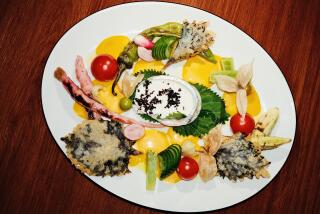An exotic antidote to the groaning table
We’ve all been there.
It’s the classic postprandial Thanksgiving moment, practically hallowed by time and tradition: You have pushed away your plate. You’re just past the point of contentment, and your stomach, stretched to its limit, has just begun to talk back, maxed out on turkey, mincemeat, stuffings, pies, puddings, yams, mashed potatoes and a host of other starchy packing materials. You’ve downed several ounces of wine, which seems to have had no effect. That marvelous word of Greek origin, “dyspepsia,” conveys your fluttery digestive state. You’re a long way from leaving the table -- walking it off is out of the question -- but there’s not really much in the way of movement anywhere else, of any kind.
If ever there was a time for the proverbial digestive, it is this moment, on the heels of the Thanksgiving meal. A rich European history of overeating has established the need for special liquors to combat its effects, to get the juices flowing and create a taste sensation in the process. Part medicine, part palliative, part social lubricant, a wonder of gustatory and remedial power, the classic digestive nimbly performs multiple tasks at the end of any Henry VIII-style repast and may well be a fitting coda for your holiday feast.
Most digestives are derived from recipes so peculiar that they almost strain the very concept of beverage -- “concoction” comes closer to the mark. The idea is to combine an alcohol base with natural botanical ingredients -- roots, flowers, leaves, herbs, dried fruit, spices -- resulting in a potent, mildly volatile tonic with which to kick-start the digestive system.
As such, taste would seem like a secondary consideration, but that hardly means these potions lack for it. On the contrary, the flavors are intense and bracing, one of a kind and nearly always possessing a bitter component -- the boot of the kick-start, if you will. They’re drawn from ingredient lists that run an arms-length and longer, from traditional local sources (or as global as the spice routes that passed through the region). Many of the recipes are centuries old, original and fiercely proprietary, their execution a closely guarded secret, like the Czech spirit distiller Jan Becher, makers of Becherovka, whose recipe, it is said, is known in its entirety by only two people at any given time.
From north to south
Digestives may be exotic, but they aren’t always obscure. In fact, if you’ve been to college -- heck, if you’ve been to a bar -- you’re probably familiar with the category’s most ubiquitous player, Jagermeister, sometimes referred to in its native Germany as “Leberkleister” or “liver glue” -- we’ll assume that’s meant in the best sense of the term.
Jager is the repository of more than 50 herbs, spices, crushed seeds and pounded roots, redolent of pine, juniper and citrus, and containing plenty of sweetness to wash down the medicine. Undeniably stimulating, its powers seem to be as much suggestive as digestive, but that seems to be a matter of context.
Many other northern countries produce similar, stomach-warming remedies.
In Denmark, the gut-check of choice is Gammel Dansk, or “Bitter Dram,” as it’s called on the label. It is considerably drier than Jager, and inclined more to flavors of anise, ginger, nutmeg, and a bitter additive called rowanberry, said to offer the added benefit of warding off not only indigestion, but witch’s spells.
Hungary makes the rare and densely herbal Unicum, produced since 1764, a barky tincture so intense that a milder formula was developed for the U.S., with flavors more given to citrus and caramel, called simply Zwack, which may or may not resemble the sound it makes as it hits your stomach.
Perhaps my favorite of these continental spirits is Becherovka, the fine pale Czech infusion with a sweet and bracing flavor of citrus, accented by cinnamon, nutmeg and other autumnal spices that would sit well alongside the tiniest sliver of pumpkin pie -- seconds, anyone?
In Italy, digestivi take an amazing array of forms: chinato, sambuca, grappa, limoncello and amaretto. But perhaps the most singular is the category known as amari, drawn from the Italian word meaning “bitter.”
That is but one of their charms. The best rely on local produce -- eucalyptus and Sicilian citrus in the case of Averna, Alpine flowers and herbs in Nonino’s Quintessentia, sub-Alpine fir fronds and spices in the marvelous (and hard to find) Torino amaro, San Simone.
Amari are so particular to place, in fact, that few are made in sufficient quantities to be distributed outside of Italy, prompting obsessive restaurateurs such as Mozza’s Joe Bastianich to forage for local product while on Italian sojourns. Bastianich snatches up obscure local bottlings and ships them to the Osteria, where general manager David Rosoff and his wine director, Jeff Porter, receive digestivi care packages -- no two are ever alike -- resulting in one of the deepest collections of postprandial offerings on this coast.
Broadly speaking, amari are warmer and more palate-friendly than their northern counterparts (they’re also lower in alcohol). There’s plenty of herbal bite, but they’re usually bound in a rich, syrupy base, which softens the punch as it warms the tongue.
Perhaps the best known is Averna, made from 60 secret Sicilian ingredients, some of which -- lemons, Tarocco blood oranges, fennel -- are detectable. The amaro Montenegro (which is in fact from Bologna) is warm and honeyed, with hints of licorice, whereas Quintessentia, from the Alpine grappa producer Nonino, is a brighter citrus flavor, given a bitter edge by something called quassia wood -- which also is used in digestive medicines. Finally the amaro Ramazzotti, from Milan, is more pine and lemon-scented, which darkens considerably in its bitter, roast cherry-skin finish.
The oddest of them all may be Cynar, notable not only for its light alcohol profile (just 16%) but also for its flavor source, cynarin, the chemical that makes the artichoke artichoke-y. Not that it tastes like one; it merely derives that singular strange bitterness from it, making everything tasted after it somehow sweeter and cleaner in its wake -- that is, if you’re still eating.
In terms of variety, Italy has the run of digestivi in Europe. But France can rightfully boast of the most famous: Chartreuse, the elixir vegetal, originating with Carthusian monks in Grenoble and first produced in 1605. One hundred and thirty herbs contribute to the singular flavor of green Chartreuse (there is a sweetened, mollified yellow version); an estate-aged bottling, V.E.P. (for vieillissement exceptionnellement prolonge or “extremely long aging”) is famed for its expense, rarity and narcotic effect.
As for its flavors -- what can I say? Few beverages defy my descriptive skills, but with green Chartreuse, I’m stumped. Minty green in color, it has a vaguely minty top note, but that aroma is quickly overtaken by a wallop of nonspecific, chlorophyllic, power-packed greenness, a densely packed ball of garrigue, pine and seaweed flavors, and with a background of something feral, alive, tightly coiled and rearing up like a pale green snake. Kapow.
Hard-core and hip
Chartreuse may be the most famous digestive in the world, but plainly the hippest, most hard-core digestive of the moment is the Italian Fernet-Branca, gracing the ledges of hipster bars from West Hollywood to Los Feliz. Though the minty, more palliative Branca-menta exists for the faint of heart, Fernet-Branca seems to push the limits of bitter, with components such as myrrh, cardamom, rhubarb and licorice -- though coca, codeine, wormwood, St. John’s wort and fermented beets have all been suspected.
Which is another way of saying that even among herbal remedies, Fernet is an acquired taste. How bitter is it? Its importation went unimpeded during Prohibition as medicine; apparently no one in the government could believe that a person would drink the stuff for pleasure.
How strong is it? For years its “mascot” of sorts was an alligator, with whose digestive prowess it was favorably linked. I took a taste to spur my memory an hour ago. I can still taste it. It is a Texas hailstorm of sensations for the mouth, deep and bright at once, with an earthy side and a minty side, astringent, dense, impossibly dry and all the more mouthwatering for it. As mentioned, it’s hard to overstate its length. Just imagine what it does when it leaves your throat.
Finally, if you wish, you can give each of your guests (of legal age) a parting gift of Underberg, a German bitter whose cute, antique 20-milliliter bottle belies the herbal potency of its contents. It comes in $5 three-packs, and I have a New York friend who keeps a few in her purse, downing one in the cab as needed after particularly extravagant wine dinners, though the flavors -- pfeffernuss, lemon rind, coffee sweetened with brown sugar -- may have her reaching for a second. She swears by them: one quick shot, and she’s on the road to recovery.
--
(BEGIN TEXT OF INFOBOX)
Where to buy digestifs
The prices for these digestifs are for 750-milliliter bottles, unless indicated otherwise.
Jagermeister (Germany) is widely available, about $25.
Gammel Dansk (Denmark) is available at Wally’s Wine & Spirits in Los Angeles, (310) 475-0606, www.wallywine.com; and Hi-Time Wines in Costa Mesa, (949) 650-8463, www.hitimewine.net, about $30.
Becherovka (Czech Republic) is available at Wally’s and at Hi-Time Wines, about $35.
Zwack (Hungary) is available at Wine House in West Los Angeles, (310) 479-3731, www.winehouse.com; Wine Exchange in Orange, (714) 974-1454, www.winex.com; and Vendome Wine and Spirits, Beverly Hills, (310) 276-9463, www.vendomebeverlyhills, about $25.
Amaro Nonino Quintessentia is available at Wine Expo in Santa Monica, (310) 828-4428, www.wineexpo.com; K&L; Wine Merchants, Hollywood, (323) 464-9463, www.klwines.com; Mel & Rose Wine & Spirits in West Hollywood, (323) 655-5557, www.melandrose.com; and the Wine House, about $40.
Averna Amaro is widely available, including at Silverlake Wine in L.A., (323) 662-9024, www.silverlakewine.com; Duke of Bourbon, Canoga Park, (818) 341-1234, www.dukeofbourbon.com; and Manhattan Fine Wines in Manhattan Beach, (310) 374-3454, www.manhattanfinewines.com, about $30, for 1 liter.
Ramazzotti Amaro is available at Wine Expo in Santa Monica; Beverages & More, (for locations, www.bevmo.com ); Silverlake Wine; and Du Vin Wine & Spirits, West Hollywood, (310) 855-1161, www.du-vin.net, about $28.
Amaro Montenegro is available at John & Pete’s Fine Wines & Spirits, West Hollywood, (310) 657-3080, www.johnandpetes.com; Vendome Beverly Hills; Manhattan Fine Wines; and Mel and Rose, about $30.
Cynar Amaro is widely available, including at Larchmont Village Wine in Los Angeles, (323) 856-8699; Wine Country in Signal Hill, (562) 597-8303, www.thewinecountry.com; Duke of Bourbon; and Wine Expo in Santa Monica, about $25.
Fernet-Branca is widely available, about $27.
Branca Menta is available at Flask Fine Wines in Studio City, (818) 761-5373, www.flaskfinewines.com; Vendome Beverly Hills; and Wine Expo in Santa Monica, about $35.
Chartreuse Verte is widely available, about $60. The VEP bottling is available at Du-Vin Wines and at Twenty Twenty Wine Merchants in West Los Angeles, (310) 447-2020, www.2020wines.com, about $150 for 1 liter.
Underberg Bitters is available at K&L; Wines; Larchmont Village Wine; Bevmo; Vendome Beverly Hills; and Woodland Hills Wine Merchant, about $5 for three (20-milliliter) bottles.
More to Read
Eat your way across L.A.
Get our weekly Tasting Notes newsletter for reviews, news and more.
You may occasionally receive promotional content from the Los Angeles Times.










